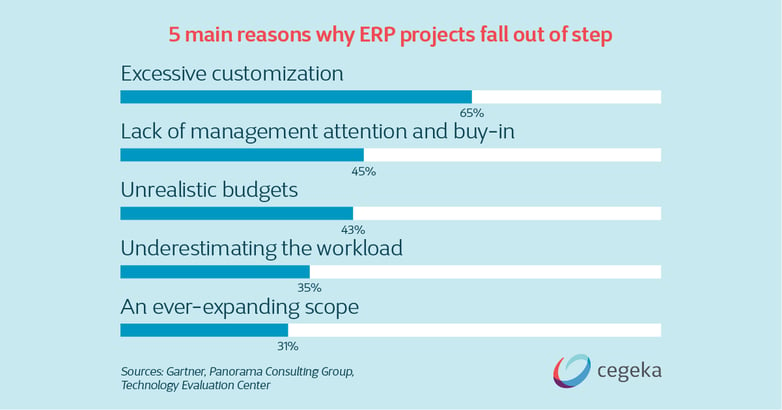Connect your ERP strategy with your business objectives
First, it’s important to get the basics right. Tackling your ERP system is an intensive and challenging process. So you’d better have your ducks in a row before you get started. Here are some questions to consider as you take those first tentative steps:
- What business goals does your ERP strategy need to achieve?
Basically, it starts with why. Why are you doing this? Because even though we love tackling these projects, we’re pretty sure you’re not doing it for fun. How does this new ERP system benefit your company? Once that’s clear, it will be easier to get everyone on board as well – from management to the people on the floor who will have to adjust their way of working.
"We needed a centralized platform that combines ERP, CRM and data, and allows for local nuances in the Benelux and France. With Dynamics 365, IT moved from a cost to a strategic means for growth."
Alexander Drost
CFO at Bieze Food Group
- What’s business-critical and what’s “nice-to-have”?
You need to find out what sets your business apart from the competition – and how your ERP can help you gain an even bigger edge. That should be your focus throughout the entire project: does this improve my business? This is also where the bulk of your resources should go. Bear this in mind, or you will get sidetracked. - How will you create – and hold – management buy-in?
While they won’t be involved in the day-to-day follow-up once the ERP project kicks off, it’s important for management to be in the driving seat. Particularly at the start, to clearly define the business objectives and share their ‘North Star Vision’ for the company (i.e. “where is the company going in the next 10-15 years?”). However, your biggest mistake would be to dismiss them after that initial exercise. An ERP project takes a long time and has its ups and downs. Keep management in the loop with regular updates: this way they won’t be confronted with any surprises. And besides, they’re a great resource to help you keep the scope in check – so use them!

Your ERP project may encounter issues for any of these reasons. The solution? Taking the time to define your business objectives!
Harmonizing your ERP steps with management and colleagues
To open the conversation and determine your business objectives, you need to invite upper management to the table. They’ll set the tone and give the ERP project a clear direction. They’ll also play a key part in the selection process – but more on that later. If you have upper management on your side, the battle’s half won.
During the implementation, operational management will lead the dance. Thanks to the predetermined business objectives, they’ll be able to do so without letting emotions run too high. They’re responsible for keeping scope and budget in check, collaborating closely with their chosen partner and making sure upper management stays in the loop – while maintaining consistent progress throughout the project.
Another reason to keep management involved, is to make sure everyone’s vision is aligned. By tying the ERP project to clear business objectives that make sense to everyone involved, you’ll be met with less resistance along the way. After all, you’re asking people to change their way of working – so the least you can do, is tell them why, right?
Want to determine your business objectives and kickstart your ERP journey? You’ll need a Solution Assessment.
Find the right path: select your scope – and stick to it
Once your business objectives are set in stone, it’s time to talk about processes. Which business processes will need to be tackled, and which are best left alone? Here’s the best measure we’ve found: ask yourself one question:
Is this process a differentiator for my business, or simply supporting?
For example: a logistics company will need a clear-cut view of its supply chain, as well as automation to speed up the process. That’s a way for them to make the difference, so it makes sense to select your ERP package on this criterion. Invoicing on the other hand is a universal supporting process: every company needs to get paid. And whatever ERP system you choose, invoicing will be included – so why invest time and resources in extra customization?
"If we want to reach a new market, we can do so very quickly thanks to the templates with best practices that are incorporated in our system."
Harm Jan Westera
Corporate IT Manager at Koppert Biological Systems
Don’t get us wrong: customization isn’t always wrong. Sometimes, it pays to tweak your ERP to fit your needs, either with a custom solution or by integrating a third-party app. Monolithic ERPs are a myth. One software to rule them all? If only! But we don’t believe in an endless patchwork of best-in-class solutions, either. As is so often the case, the truth lies somewhere in the middle. And that’s where we want to be, together in tech with you.
Let's work together in Tech?
Cegeka and Microsoft Dynamics 365: it's a perfect match! Get in touch and let’s discuss your ERP project together.
Together in Tech: there’s no I in ERP
To successfully start and finish an ERP project, we need to work on it together. Join us and our customers as we zoom in on all things ERP – from the perspective of true partnership. Check out all the Together in Tech articles here.




